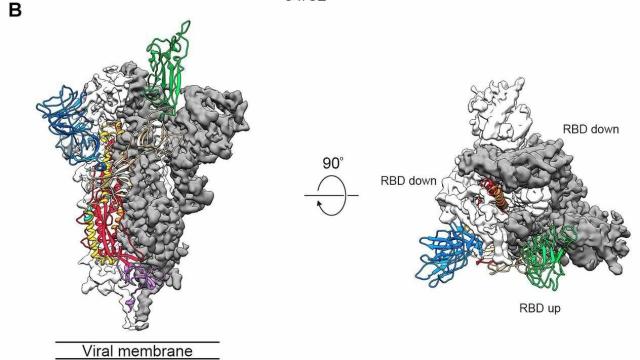Scientists studying the new coronavirus that has infected tens of thousands of people in China have published an atomic-resolution image of the protein that the virus uses to gain access to cells. This feat, which was accomplished using a Nobel Prize-winning method, could aid in the development of treatments or vaccines.
The novel coronavirus (officially called SARS-CoV-2) has infected over 75,000 people and killed at least 2,000 since it emerged late last year. As part of an effort to cure patients and stop the virus’s spread, scientists have created in-depth images of it using the Nobel Prize-winning cryo-EM technique. Specifically, they targeted the virus’ spike (S) glycoprotein used to gain entry into target cells; understanding the structure will hopefully allow researchers to quickly develop treatments.
Scientists published the genome of the virus just weeks ago, and using that data, another team, led by Daniel Wrapp at the University of Texas, Austin, created and purified the S proteins. The S protein looks for a receptor on the host and then binds and fuses to the target cell; its importance to the transmission process means that the S protein could be a good target for treatments or vaccines.
[referenced url=” thumb=” title=” excerpt=”]
The team used cryo-electron microscopy, also called cryo-EM, to image the S protein’s structure. Cryo-EM is a process by which scientists quickly freeze a molecule in place and then bombard it with electrons to create over 3,000 two-dimensional projections of the virus. Then, they combined the images to create a 3D reconstruction of the protein, which they published today in the journal Science.
The structure of SARS-CoV-2’s S protein looks a lot like that of SARS-CoV, the virus that sickened 8,098 people in 2003, and indeed, both viruses bind to the same receptor on host cells, called angiotensin-converting enzyme 2 or ACE2. However, the researchers’ initial analysis demonstrated that the new coronavirus’s S protein has a much higher affinity for this receptor, which is perhaps a reason why the new virus spread so easily, though that’s just a hypothesis. The team also reported that antibodies intended to bind to the SARS-CoV S protein did not bind to the new coronavirus’s S protein, which means that antibodies intended to fight SARS-CoV likely have trouble recognising the new coronavirus.
Hopefully, the researchers write, the knowledge of SARS-CoV-2’s S protein down to the atomic level will allow for the engineering of proteins that can stop the virus in its tracks.
